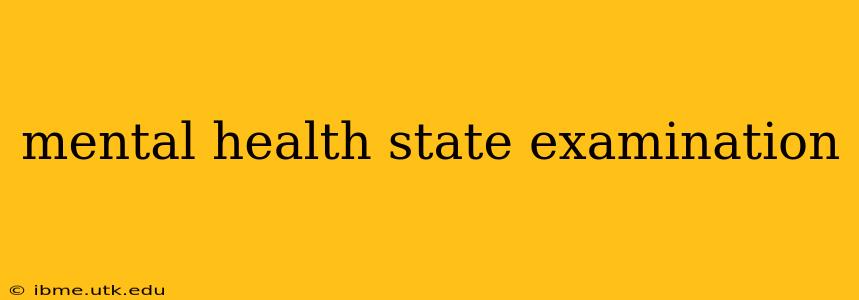The mental state examination (MSE) is a crucial tool used by mental health professionals to assess a patient's current psychological state. It's a systematic process of observation and questioning designed to gather detailed information about various aspects of a person's mental functioning. This guide provides a comprehensive overview of the MSE, explaining its components and significance in mental health care.
What is a Mental State Examination?
A mental state examination is a structured way of observing and describing a person's behavior and mental state at a specific point in time. Unlike a psychiatric history, which focuses on the past, the MSE focuses on the present. It's a snapshot of the individual's psychological functioning, providing vital information for diagnosis, treatment planning, and monitoring treatment progress. The MSE is not a standalone assessment but a critical component of a complete psychiatric evaluation.
Key Components of a Mental State Examination
The MSE typically covers several key areas, although the specific elements and depth of examination can vary depending on the context and the clinician's approach. Here are some core components:
1. Appearance and Behavior
This section observes the patient's overall appearance, including dress, hygiene, posture, and any noticeable physical features. Behavioral observations encompass motor activity (e.g., restlessness, agitation, slowed movements), eye contact, mannerisms, and any unusual or noteworthy behaviors. For example, is the patient neatly dressed or disheveled? Are they agitated or lethargic? Do they maintain eye contact appropriately?
2. Speech
This assesses the quality and characteristics of the patient's speech, including rate, rhythm, volume, and fluency. Is their speech pressured (rapid and difficult to interrupt), hesitant, or slurred? Are there any noticeable speech impediments or abnormalities?
3. Mood and Affect
Mood refers to the patient's subjective emotional state, while affect describes the observable expression of their emotions. The clinician assesses both the reported mood (e.g., "I feel depressed") and the observed affect (e.g., flat, blunted, labile, or appropriate). Inconsistencies between reported mood and observed affect can be significant.
4. Thought Process and Content
This examines how the patient thinks (thought process) and what they think about (thought content). Thought process aspects include the organization, flow, and coherence of thoughts. Is the thinking linear and logical, or are there disruptions such as flight of ideas, loose associations, or thought blocking? Thought content delves into the themes and preoccupations of the patient's thoughts, looking for evidence of delusions, obsessions, or suicidal ideation.
5. Perceptual Disturbances
This section investigates whether the patient experiences hallucinations (false sensory perceptions) or illusions (misinterpretations of real stimuli). The type, frequency, and content of any perceptual disturbances are documented.
6. Cognition
Cognitive assessment explores various aspects of mental functioning, including orientation (to person, place, and time), attention and concentration, memory (immediate, recent, and remote), and higher cognitive functions (e.g., abstract reasoning, judgment). Simple tests might be used to assess these functions.
7. Insight and Judgment
Insight refers to the patient's awareness of their illness and its implications. Do they understand that they have a problem and need treatment? Judgment refers to their ability to make sound decisions and appreciate the consequences of their actions. Clinicians assess judgment by asking hypothetical questions or exploring past decision-making.
8. Risk Assessment
A critical component of the MSE is the assessment of risk, including risk of harm to self (suicide), harm to others (homicide), or neglect of self. This requires careful evaluation of the patient's thoughts, behaviors, and overall mental state.
What are the uses of the Mental State Examination?
The MSE serves several vital purposes:
- Diagnosis: The MSE provides crucial information for formulating a psychiatric diagnosis.
- Treatment Planning: The findings guide the development of an individualized treatment plan.
- Monitoring Treatment: The MSE allows clinicians to track the effectiveness of treatment and make adjustments as needed.
- Legal Context: In forensic settings, the MSE can be a critical piece of evidence.
- Research: The MSE is used in research studies to assess the effects of interventions and to characterize different mental health conditions.
How is a Mental State Examination Conducted?
The MSE is typically conducted through a combination of observation, direct questioning, and the use of standardized assessment tools. The clinician creates a narrative report summarizing their observations and findings. The process emphasizes empathy, active listening, and a non-judgmental approach.
This detailed explanation should provide a solid foundation for understanding the Mental State Examination. Remember, this information is for educational purposes and shouldn't be substituted for professional medical advice. If you have concerns about your mental health, please consult a qualified healthcare professional.
